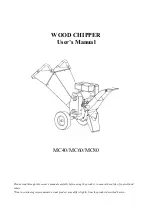
Blue Box 45
coil obstructs the passage of air and reduces the available heat exchange surface area (and thus the thermal
efficiency) and can damage the heat exchanger.
Defrosting is the procedure that eliminates the ice that has formed on the evaporator coil during heat pump mode
operation of an air/water unit.
Defrosting is performed simultaneously for the entire unit.
All heat pump versions are equipped with a control that activates an automatic coil defrost cycle when necessary.
After starting however, the first defrost cycle will be started after a preset minimum operating time to allow the
formation of sufficient thermal inertia to allow the cycle to be completed successfully.
Defrost cycle activation is based on the detection of a low suction pressure value due to insufficient heat exchange
between the evaporator and the air due to the formation of a layer of ice, which exerts a thermal insulation
effect. For a defrost cycle to be able to start a suction pressure of at least one of the currently operating compressors
must remain below the pressure set for the defrost cycle trip signal for a preset time interval.
Before starting to defrost the coils, all the compressors are started, after which the unit reverses its operation from
heat pump to chiller mode.
When the cycle is reversed the fans stop and the compressors force hot gas into the coil.
A pressure switch on the high pressure circuit maintains the discharge gas pressure below the defrost end value.
To maintain the pressure lower than the defrost end pressure the pressure switch activates the fans.
To reduce the air flow and obtain more efficient heating of the outer part of the coil, the pressure switch signal
causes the fans to rotate in reverse.
When the defrost end temperature is reached, as measured by a thermostat with a probe located in the lower
part of the coil, the pressure switch allows the discharge pressure to reach the defrost end pressure.
When the defrost end pressure has been reached, the controller reverses the unit from chiller mode to heat pump
mode, thereby terminating the defrost procedure.
Even though in certain conditions the surface temperature of the coil and the condensation pressure fail to reach
the defrost values within the preset time limit, the defrost cycle is forcibly terminated as though the defrost end
signal were present. The controller restarts the fans, and when the pressure lowers again to the preset value, it
reverses the unit’s operating mode again.
If the defrost cycle is forcibly interrupted, with the timeout signal, a message is displayed on the controller,
although no controller functions are activated.
The defrost timeout alarm is automatically cleared from the active alarms menus when a defrost cycle terminates
normally because the defrost end pressure has been reached. In any event, the alarms historical file will contain
a record of all defrost cycles that were terminated forcibly due to a timeout intervention.
Consecutive defrost cycles must be at least 30 minutes apart. If the forced defrost signal persists, inform the
Service organisation.
5.2.16 Total heat recovery (option)
Heat recovery is the function where all the energy that would normally be rejected to the air cooled condenser is
recovered at a refrigerant to water condenser installed in series with the air-cooled condenser.
The heat recovery process is managed by the microprocessor controller.
During energy recovery the fans are stopped and the condensing coil is by-passed via solenoid valves connected
downstream of the thermostat valve. The machine is equipped with a liquid receiver.
Heat recovery can only occur when the water temperature at the recovery exchanger inlet is lower than the
recovery set-point. Heat recovery is terminated when the temperature increases by the recovery differential
value.
It is mandatory to use a condensing pressure control valve (one for each hydraulic circuit) or three-way valve,
fitted by the installer, to avoid condensation values that are incompatible with operation of the machine.
5.2.17 Dual set-point (option)
Operation with a dual set-point is possible only in chiller mode.
With double thermostatic valves and solenoid valves that are automatically switched according to the required
expansion temperature. Two set-point values can be programmed on the microprocessor controller via the keypad
or a digital input. Switching of the thermostatic valves is always automatic, in accordance with the water tempe-
rature.
The valves are sized on the basis of the temperature values specified at the time of the order. The machine
operating limits shown in the catalogue are not affected. If the hydraulic circuit contains glycol in sufficient
Summary of Contents for KAPPA V SR
Page 2: ......
Page 6: ......
Page 29: ...Blue Box 23 HYDRAULIC CIRCUIT DIAGRAM VERSION KAPPA V SR ST 2PS...
Page 40: ...Blue Box 34 ELECTRICAL PANEL LAY OUT MODELS 65 2 100 2...
Page 69: ...Blue Box 63 KAPPA V SR REFRIGERANT CIRCUIT...
Page 70: ...Blue Box 64 KAPPA V SR HP REFRIGERANT CIRCUIT...
Page 71: ...Blue Box 65 KAPPA V SR DC REFRIGERANT CIRCUIT...
Page 80: ...Blue Box 74...
Page 81: ......
















































